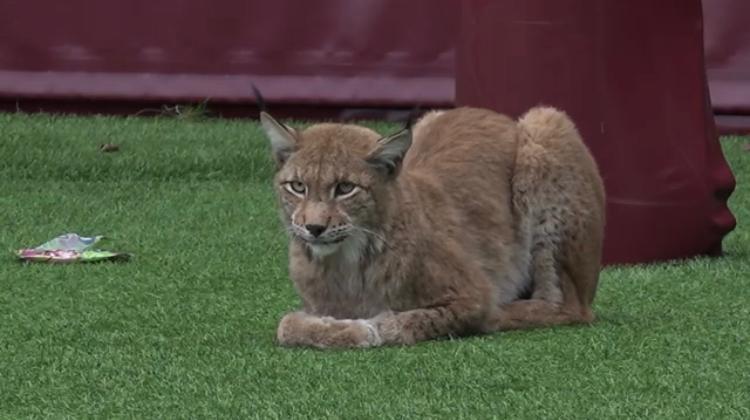Long Live the Lynx!
Some of you may remember the strange and exciting incident that took place about 3 months ago on our very sports field here at FIS. This event that took place in our school was even on national news for a while after it happened, gaining a huge presence on the media, as it was so unaccounted for before. Have you guessed what it was? This event caused a huge commotion and even initiated a debate over our school sports team name, some considering changing it from “warriors” to “wildcats”.
The event I am discussing is the discovery of a lynx on the lower sports field in the morning before school on September 4th. This event is almost laughably peculiar, as many of us cannot begin to comprehend it alone, never even considering how it could have taken place. For those who still need more reminder, the lynx, later identified as M12, just happened to show up on the field near the upper-school. Luckily, the three students that found it took the safe decision of informing a teacher, Mrs Cowan. Meanwhile, one of them stayed behind to make sure that the younger grades wouldn’t get too close to the dangerous big cat (FIS Media Team). Eventually, the crisis was resolved by the local authorities scaring it back into the forest, and the attention M12 received faded.
The animal was meant to retreat back into the forest where it came from. However, this was not the case. In fact, the Hochtaunuskreis informed locals that it had stayed in the city and was discovered in a private garden of a house by one of the residents. M12 wouldn’t end up leaving this location in the neighbouring municipality of FIS for another week! (www.hochtaunuskreis.de) Eventually, the police decided to anaesthetise the animal and transport him over to the Opel Zoo in Kronberg for examination.
Dr Uta Westerhues, a specialised doctor for zoo animals in the Opel Zoo (Fachärztin für Zootiere), clearly explained why this phenomenon was considered so out of the ordinary. She described that “The cat behaved almost familiar to humans, did not show any shyness, which for a lynx can be described as quite unusual behavior.” It was later found out that this familiarity was in reality something negative. I was later identified that the lynx came from the Harz Mountains and had been equipped with a transmitter in Bad Pyrmont in 2018 as part of the lynx project. In the same year, it migrated through North Rhine-Westphalia to Hesse, where it lost the transmitter (The Canadian). This project may partially account for its interactions with humans.
Westerhues also suggests that “it is clear that all subadult lynxes wander around in search of a territory and a female”, and that though it was a “very long journey [that] is quite unusual” there is “nothing to worry about”. As lynxes are often in search of a partner, “The need for other lynxes may also be the reason for the lynx’s remarkable migration performance”. Overall, we are still not certain for the reason the lynx came to our field, but the distemper disease it had carried could have also affected his reason for appearing.
After the lynx’s refusal to leave the city, she explained how the “Lower nature conservation authority has contacted Opel-Zoo and asked for help”. From there, she described how “We did a careful examination, including blood work and x-ray of the whole body, but could not detect anything obvious wrong with the animal.” Therefore, as protocol dictates, M12 was going to be released back into the wild where it belonged with the help of wildlife and species protection stations up in the north of Germany. Yet his condition continued to worsen with no clear cause, so a CT (computer tomography) was issued. Westerhues explains how “The CT images show degenerative changes in various areas of the brain”, and M12 was finally sent to the pathology where it was identified to have distemper. Referring to the paragraph above where the disease is also mentioned, an explanation describing clearly what it is can be read in the paragraph below.
Distemper is a viral disease affecting various organs depending on each case, with symptoms such as fatigue, fever, diarrhoea and vomiting or respiratory symptoms. However, Uta explains how it is commonly encountered in “hyenas, martens, small bears and red pandas” but only “very rare in bigger cats”. In the case of our M12, only the brain was damaged and central nervous system impairment took place without any of the other symptoms, making it hard to diagnose the disease immediately. Moreover, she stated that “It cannot be said for sure where the lynx got infected. But, since in a sick dog all secretions and excrements contain virus material, it is easy to imagine that the lynx got infected by exactly those excrements.”.
Ultimately, “Because the lynx was not able to eat on his own, to clean himself or even walk straight, it was decided to euthanize him”. This decision of putting M12 down may seem like a sad one, but it was the best choice that could be made with the poor animal suffering and being unable to take care of itself.
Of course, this should make use think not only of this one lynx dying but of all the animals and humans now in danger of sickness and how we should do our best to protect those we care about. This event tested the school’s capabilities of handling crises and clearly, FIS was committed to helping the lynx!
Interview:
About 2,5 months have passed since a male lynx attracted attention. His excursion to the sports field of your school on the 4th of September and the accompanying report made him known beyond the borders of our region. The cat behaved almost familiar to humans, and did not show any shyness, which, for a lynx, can be described as quite unusual behavior. After he had left the sports field, he retreated in the following days to a nearby residential area of a neighboring municipality. Here he stayed in the garden of a private house continuously for more than a week. That’s when the Lower nature conservation authority contacted the Opel-Zoo and asked for help. Due to the behavioral observations made in the garden, the responsible authorities decided to anaesthetize him for the precautionary protection of humans and animals, and to place him in the Opel Zoo for a short period of time for examination. We did a careful examination, including blood work and x-rays of the whole body, but could not detect anything obviously wrong with the animal. With the aim of releasing the lynx back into the wild after further examinations, the animal was handed over to a wildlife and species protection station up in the north of Germany, which was experienced in handling the lynx. Since his condition worsened the veterinarians performed a computer tomography (CT) and liquor examination. The CT images showed degenerative changes in various areas of the brain. Because the lynx was not able to eat on his own, to clean himself, or even walk straight, it was decided to euthanize him. As it is protocol, he was then sent to the pathology, where they finally detected distemper. Distemper is a viral disease that has been known for centuries in domestic dogs. It has been observed in hyenas, martens, small bears and red pandas as well, and is very rarely found in bigger cats. The disease is characterized by high fever and fatigue. Depending on the organ system affected, diarrhea and vomiting or respiratory symptoms can occur. As the disease progresses, the brain and central nervous system can be damaged and symptoms can occur. Only the last was the case with the lynx. It cannot be said for sure, where the lynx got infected, but since the excitement of all sick dogs can contain virus material, it is easy to imagine that the lynx got infected by exactly those excrements.
Regarding your question why the lynx was seen in Oberursel: it is clear that all subadult lynxes wander around in search of territory and females. He originally came from the region Harz. This very long journey is quite unusual, but nothing to worry about. Usually they only stay where they have contact with other lynxes in the neighborhood. The need for other lynxes may also be the reason for the lynx’s remarkable migration performance.









S • Dec 17, 2020 at
I love this article, the amount of detail and creative perspective of it! I love how detailed and informative this article was without being too monotonous, and overall, I think that the author did a great job.